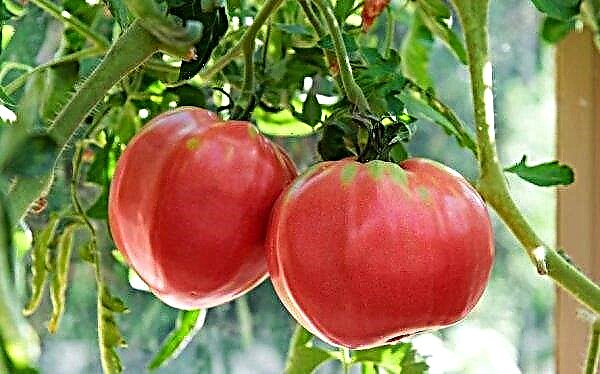Orchid is a popular flowering plant that decorates rooms of almost any purpose. In order for a potted orchid to bloom again and again, it must be provided with a special moisturizing regime that mimics the natural setting of a flower. How to organize such watering will be discussed in the article.
How to care for an orchid
In the natural environment, an orchid grows on trees, and its roots are exposed to the sun, air and water. To successfully grow this capricious flower at home, you must follow the basic rules for caring for it.
Did you know? The author of the modern theory of evolution, Charles Darwin, devoted a separate scientific work to the methods of pollination of orchids. The work captures many details about the plants that delighted him.
We offer a brief memo for those who are just going to cultivate this amazing plant:
- Provide the flower with bright light, but try to isolate it from the direct afternoon rays of the sun.
- Orchids are much more tolerant of drying out than of supersaturation with water, so sometimes arrange short periods of drying of the substrate.
- Keep the temperature in the room within +10 ... + 30 ° С.
- Provide high humidity in the apartment. A flowering plant prefers moist air, similar to the atmosphere of the tropics. To do this, for example, you can keep the pot in a pan with pebbles filled with water.
- Orchids love a lot of fresh air, both around the roots and leaves. Create conditions for the movement of air around the roots. Make sure that the tank has drainage holes. Proper watering will be violated if there are no openings in the tank through which water can drain freely.
- Use containers specifically designed for orchid cultivation. They are usually made of terracotta clay. The presented plant can also be grown in a glass pot, the main thing is that the container has additional drain holes at the bottom or sides.

How to understand that it’s time to water the orchid
Illiterate watering is the most common cause of death of house orchids. Some species of these flowers are endowed with an organ for the accumulation and storage of water (for example, dendrobium, cattleya, odontoglossum and oncidium), while others lack this ability (among them miltonia, papiopedilum, phalaenopsis and cymbidium).
If your flower can accumulate water, allow the earthen mixture to dry completely before watering. If you own an orchid of the second type, moisten it before the soil is completely dry. Being unsure of what type your specimen belongs to, water it at the moment when there is still some moisture in the substrate.
The moisture level of the substrate is also calculated by the presence or absence of condensate drops on the walls of the vase. If the container is opaque, the presence of moisture is determined by the degree of immersion in the soil of a wooden stick.
Finger testing is the best way to determine if a flower needs water. Attach the little finger to the soil: if you do not feel moisture or a little - it's time to water. Once you feel the wet mixture, wait a while with watering. Doubting the state of the substrate, repeat the test every other day.
The fact that there is enough moisture is indicated by the saturated green color of the roots. Light roots are a signal for watering.
Did you know? Orchids with inflorescences of blue tint in nature are quite rare. The only species is Phalaenopsis Aphrodite, bred after years of experimentation by Japanese scientists at Chiba University. Often, gardeners resort to banal staining of the flower with chemicals to make the orchid turn blue.
Lift the flowerpot to check its weight. If it is heavy, then there is still water inside. If the flowerpot is light, it's time to water it.
How many times and how often to carry out the procedure
Regarding how many times a week, per month, orchids need a new portion of water, there is no exact regime on this issue.
The frequency of irrigation is influenced by a number of external and internal factors:
- biological characteristics of the plant (life cycle);
- growing method;
- season;
- the amount of sun received;
- soil features;
- indoor microclimate - temperature indicator and humidity level.
Since these factors vary by region, there is no single irrigation rule. You will have to develop your own schedule to suit your specific environment.
The lower the illumination, the temperature, and the finer the substrate, the less water demand for orchids. For example, if the room is cool, the flower should be watered less often than when the temperature is higher. If the plant is placed on a sunny windowsill, it needs to be moistened more often than if it was standing in a darker place.
In addition, different soil mixtures hold different amounts of water (for example, pine bark stores water longer than charcoal or clay granules).
Important! No orchid variety should be watered every day. Oversaturation with moisture can cause rotting of the root system, and eventually — and plant death.
For most indoor varieties, watering 1-3 times during the week in summer and 1-2 times per week in winter is acceptable. Water the flowers in the morning, so that in the evening in the axils of the leaves there is no moisture left.
What water is better to water
For a long time, experts insisted that orchids only need rainwater. Today, most owners of potted orchids use tap water without any problems. The only requirement is that tap water must be defended for 3-4 days before irrigation.
However, if you find abnormal deposits on the roots, you should look for a new source of water. Water from the tap can be mixed with a distillate in a ratio of 1 to 2. It is even better to take a boiled or thawed analog. Water temperature should not be lower than + 18 ° С, the optimum indicator is +30 ... 35 ° С.
Pure distilled water is not suitable for irrigation. Also, beware of water that has been treated with harsh chemicals. Rainwater can be used only if it was collected outside the city, and so that bacteria do not multiply during storage, keep it in the refrigerator or cellar.
How to water an orchid at home: ways
The following are the most common and effective methods for irrigation of potted orchids.
Immersion
Immersion is the most favorable technique for moistening the flower in question. For the implementation of the method, a special flower pot is ideal. If not, use a tall pan larger than the pot itself. Immerse the flower in an empty pan, holding the flowerpot, fill it with water. When the water reaches the sides of the flowerpot, fix the flower in a pan using the items available on the farm. Foliage and stem should not get wet. The dive should last about 10-20 minutes. At the end, remove the pot and let the remaining water drain.
Immerse the flower in an empty pan, holding the flowerpot, fill it with water. When the water reaches the sides of the flowerpot, fix the flower in a pan using the items available on the farm. Foliage and stem should not get wet. The dive should last about 10-20 minutes. At the end, remove the pot and let the remaining water drain.
Did you know? In eastern countries, the salep drink, which is made from tubers of orchids, is popular.
Watering from above
The next watering option is suitable for flowering specimens. To moisten the soil, a watering can with a long nose is suitable from above. Dip the flowerpot with the plant in a deep bowl, then water the substrate from the watering can from above. Carefully control the water jets so that moisture does not enter the sinuses of the leaves, as this is fraught with decay of the growth point and death of the flower. Spray water evenly over the entire surface of the soil. Drain any remaining moisture immediately.
Carefully control the water jets so that moisture does not enter the sinuses of the leaves, as this is fraught with decay of the growth point and death of the flower. Spray water evenly over the entire surface of the soil. Drain any remaining moisture immediately.
Running water
The easiest way to irrigate is to keep the pot under the tap and let the water reach room temperature on the soil. It is advisable to use a nozzle on the tap, which allows you to disperse the water, and not just run one strong stream of water onto the plant. So, direct running water to the ground under the orchid. Continue the procedure for about one minute, allowing water to seep through the pot and exit the holes at the bottom.
Continue the procedure for about one minute, allowing water to seep through the pot and exit the holes at the bottom.
The rate of exit of water from the drainage holes should be sufficiently high. If the water lingers in the pot, then the soil mixture that you use is too dense.
After waiting a few minutes, check the pan - the remaining moisture should drain from the roots. Drain all the water and return the flower to the windowsill.
Spraying the roots
Since the orchid feels good and blooms in a humid environment, spraying the roots is a great way to keep the flower healthy and prevent the roots from drying out. So, your task is to fill the sprayer with suitable water, then treat the roots of the plant. The volume of water depends on the environment in which the plant is located.
So, your task is to fill the sprayer with suitable water, then treat the roots of the plant. The volume of water depends on the environment in which the plant is located.
Important! Do not let water collect on the leaves. All moisture from the leaves must be blotted with napkins.
Consider how to water an orchid in certain cases:
- After the purchase. The first watering is carried out only on the 7-10th day. In stores, orchids are moistened with softened and disinfected water, so a flower can respond negatively to tap water.
- After the transplant. It is not worth it to irrigate a newly transplanted flower abundantly. It is enough to immerse the pot in water for half an hour or a little less. The first full-fledged hydration is best done after two weeks (using a pallet or cache-pot). If the soil is too dry, treat it from the spray gun.
- During flowering. An orchid in the indicated period prefers a moist substrate, therefore, a flowering plant should be moistened 2-3 times in 15 days. However, uncontrolled watering is fraught with the death of the kidneys. Therefore, do not use immersion technology every time, it’s better to moisten the earth a little from above.
- In the winter. In the cold season, orchid needs are reduced. Therefore, do not moisten the flower more than 1 time in two weeks. Since the rhizome slowly absorbs moisture in the winter months, it is advisable to use the immersion method.
Is it possible to water an orchid
Next, we’ll talk about the feasibility of using biostimulating drugs such as succinic acid and rootin.
Succinic acid
This substance is often called "living water" for an orchid. The drug can not act as a complete replacement of fertilizing, but it accelerates growth, provokes flowering, strengthens the immunity of young plants. In addition, succinic acid also improves soil quality:
In addition, succinic acid also improves soil quality:
- improves microflora;
- destroys toxins;
- accelerates the absorption of other nutrients by plants.
Kornevin
Kornevin - root-forming agent, indispensable in the case when the orchid is left without a root system. The tool does not allow the remainder of the plant to die, and also contributes to the rapid germination of new roots. The substance is also used in the process of propagation of a flower.
The substance is also used in the process of propagation of a flower.
Important! When used correctly, no harmful effects of succinic acid and root on orchids have been identified.
Signs of improper watering
Rare or illiterate watering can provoke:
- drying or decay of the roots;
- stunting and flowering;
- withering or premature drying of flowers and unblown buds;
- the situation when the orchid changed color (the flowers began to fade);
- the formation of dark patches on green areas, increasing with continued irrigation;
- the formation of a large number of yellow leaves;
- burn of leaves.
As you can see, when watering orchids in different periods and in different situations, it is necessary to strictly observe the rules developed by nature itself. Only then will this amazing plant bloom in a timely and magnificent manner and grow well.












